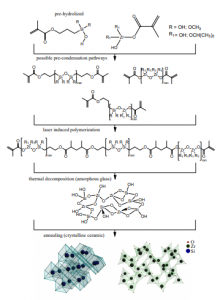
Micro-graphs of different initial and treated structures (1000 ◦ C for 2h). Down-sizing of solid volumetric and free-form structures (with correspondingly high and low initial volume fractions of polymer). From top to bottom: (a) a free-form sculpture Vytis (Coat of arms of Lithuania), (b) homogeneous cube structure, (c) photonic crystal (periodic) structure with cage and (d) hexagonal scaffold.
Many methods are used to develop 3D printing materials, and the sources for new 3D printing materials are seemingly endless. In a study entitled “Additive Manufacturing of 3D Glass-Ceramics down to Nanoscale Resolution,” a group of researchers use a sol-gel resin to fabricate an inorganic ceramic.
Illustration of the main steps in synthesis of ceramics out of hybrid SZ2080 followed from laser induced polymerization that occurs during direct laser writing. During first stage of calcination, organic part is removed from the matrix and an inorganic glass matrix forms. As temperature is increased further, crystallization occurs and polycrystalline ceramic phase forms. Crystal structure of cristobalite and t-ZrO2 are shown in bottom row.
“Fabrication of a true-3D inorganic ceramic with resolution down to nanoscale using sol-gel resist precursor is demonstrated,” the researchers explain. “The method has an unrestricted free-form capability, control of the fill-factor, and high fabrication throughput. A systematic study of the proposed approach based on ultrafast laser 3D lithography of organic-inorganic hybrid sol-gel resin followed by a heat treatment enabled formation of inorganic amorphous and crystalline composites guided by the composition of the initial resin.”
A popular hybrid organic-inorganic sol-gel resist SZ2080 was converted into a material with entirely different properties through polymer-to-ceramic transition via high temperature sintering and oxidation. The silica and zirconia in the original material in the resist in the 20% inorganic part of the component led to the emergence of silica and zirconia crystalline phases in the final sintered ceramic material. In addition, “a proportional downscaling of the 3D polymerized object takes place with significant volume change of 40-50% dependent on annealing protocol without distortion of the proportions of the initial 3D design,” meaning that complex nanoscale patterns can be formed.
For the experiment, the researchers 3D printed different structures including bulk-cubes, periodic-3D woodpile micro lattices, free form structures, micro-sculptures, combining bulk and nanometer feature elements with complex bends, and macroscopic hexagonal 3D lattices which are usually used as artificial cell scaffolds.
“As the temperature increases the spectral shape changes and evolves via qualitatively two distinct form-factors,” the researchers state. “Close examination of the initial spectrum and comparison to that for T = 1000◦C reveals that they differ by the molecular vibrations which can be associated with the carbon-carbon, carbon-oxygen, carbon-hydrogen bonds. After heat-treatment those spectral lines vanishes. The new spectral form coincides with that typical for silica glass; we measured a control sample of fused silica.”
High temperature calcination of the 3D polymerized structures, created by 3D laser writing in the SZ2080 polymer resist, produced either silica-based glass or a polycrystalline ceramic pure inorganic material. A glass phase dominated in samples annealed at temperatures up to 1200°C, while formation of polycrystalline silica and zirconia was observed in samples annealed above 1200ºC.
“The presented modifications of silica-zirconia-rich resist SZ2080 from glass to polycrystalline ceramic by annealing shows a principle of the thermally guided 3D material printing which has nanoscale resolution,” the researchers conclude. “Isotropic down-sizing of the initial 3D polymerized objects with a volume fraction of 0.5-to-1 simplifies fabrication since there is no need to alter proportions of the initial material as it is widely used in DLW 3D nanolithography of photonic crystals, micro-optics and biomedical scaffolds in order to eliminate the effect of anisotropic shrinkage.”

Uniform 3D down-scaling by 3D nano-sintering. SEM micro-graph of a ceramic micro-sculpture after sintering at 1200◦C for one hour (right). Initial material SZ2080 resist (all dimensions were 1.7× larger; note the different scale bars)
The mechanical properties of the final structures, according to the researchers, acquire new features, such as resilience in harsh physical and chemical environments.
“Since nanoscale materials can initiate precipitation and guide growth of nano-crystallites, a wide field for experimentation horizons are widened by the presented modality of additive manufacturing,” they add.
Authors of the paper include Darius Gailevicius, Viktorija Padolskyte, Lina Mikoliūnaite, Simas Šakirzanovas, Saulius Juodkazis and Mangirdas Malinauskas.
Discuss this and other 3D printing topics at 3DPrintBoard.com or share your thoughts below.
Subscribe to Our Email Newsletter
Stay up-to-date on all the latest news from the 3D printing industry and receive information and offers from third party vendors.
You May Also Like
Nikon’s AM Expansion from California to Japan and Beyond: CEO Hamid Zarringhalam Weighs in
As we recently argued in a 3DPrint.com PRO article, Nikon Advanced Manufacturing has quickly gone from a prominent player in the metal additive manufacturing (AM) sector to become one of,...
The State of the Talent and Job Market in AM: 2025 Outlook
The additive manufacturing industry has seen significant shifts in recent years, with 2024 marking a critical turning point. Economic pressures, evolving hiring trends, and an increasing talent shortage at the...
SWISSto12 to 3D Print Antennas for SES’s Medium Earth Orbit Satellite Constellation
SWISSto12 has made a remarkable journey in satellite manufacturing. The company now produces its own HummingSat, as well as 3D-printed filters, waveguides, and other RF components. Recently, it was selected...
3DPOD 243: Volumetric 3D Printing with Xolo CCO, Stephan Kuehr
Stephan Kuehr began his career at 3YOURMIND before joining the volumetric 3D printing firm Xolo. In this episode of the 3DPOD, we discuss Xolo, its technology, volumetric 3D printing, bioprinting,...






























